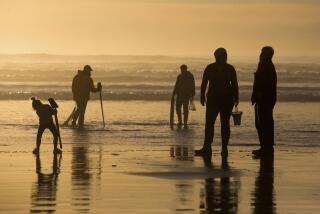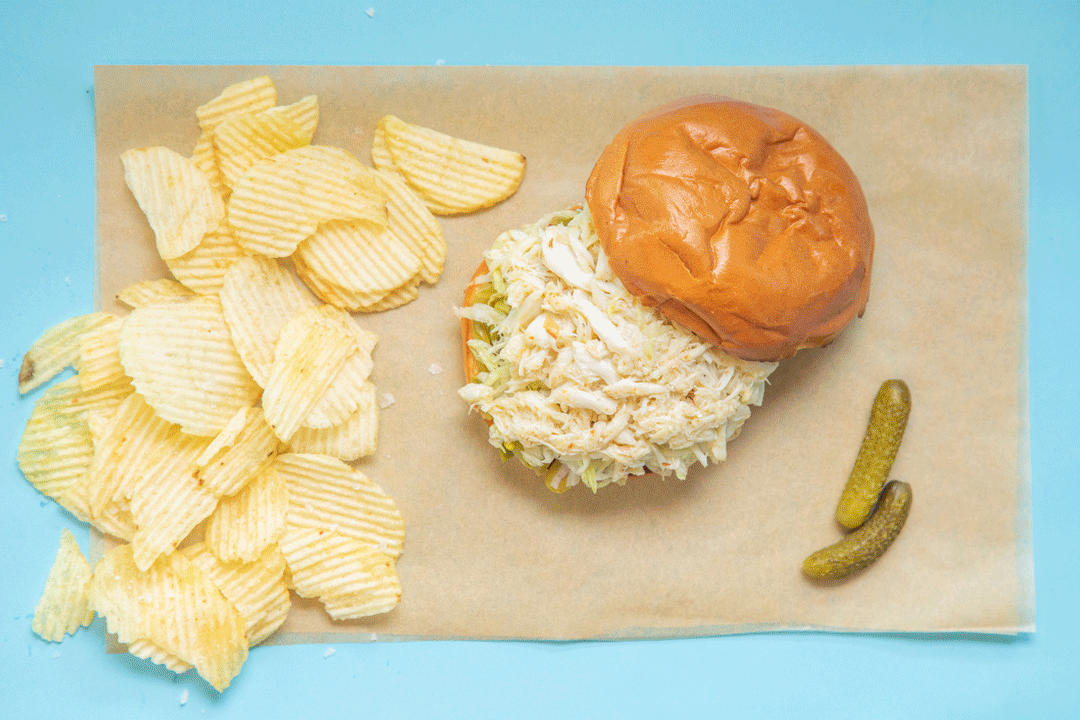Questions Arise as a Bay’s Crab Bounty Is AWOL
- Share via
TANGIER SOUND, Md. — Dwight Marshall hoists his crab pot onto the deck of the Miss Marshall and opens the hatch. Inside are half a dozen jellyfish, a few blades of grass and four scurrying peeler crabs.
Over two hours, he will pull up a hundred more pots and every time it is the same: a lot of worthless sea creatures and only a few of the soft-shell crabs that keep watermen afloat financially.
For the crabbers who work the choppy waters west of Crisfield, Md. -- historically the cradle of crab bounty -- this summer is shaping up to be the worst in decades. Since May, when the crabs typically shed their shells en masse and watermen make the money that gets them through the winter, Marshall and his fellow crabbers have endured skyrocketing expenses for fuel while the catch has been terrible.
Though the state doesn’t yet have numbers for the summer, the ferry loads tell the story. Smith Island crabbers usually ship about 25 boxes a day to markets in Crisfield, each box holding up to 18 dozen soft-shells. In July, the ferry was hauling just four boxes a trip.
“It’s up there among the worst seasons, I’ll put it that way,” said Marshall, who has been a crabber for more than 40 years and is known as one of the island’s best.
Even in good years, peelers account for less than 10% of the Chesapeake Bay crab harvest. Conditions needed for shedding are so specific that a poor peeler catch doesn’t tell scientists much about the hard-crab season, said Lynn Fegley, a fisheries director at the Maryland Department of Natural Resources. Fegley’s numbers show that watermen harvested about 1.4 million pounds of hard crabs from Maryland’s portion of the bay in May, the last month for which numbers are available. That figure is slightly above average for recent years.
The peeler harvest is measured in mere thousands of pounds, but to the watermen of Smith Island and other Tangier Sound communities, those numbers mean everything.
More than 90% of the state’s soft crabs come from Tangier Sound, and nearly every islander’s living is tied to the season. Men in the three island towns of Tylerton, Rhodes Point and Ewell rise before sunset and ride out to their peeler pots -- steel cages that sink and trap the crabs as they scuttle along the bottom. Some crabbers prefer to use a scrape that drags along the bottom.
The men return home by midafternoon and place the crabs in a sloughing tank, where they check them every few hours to see if they’ve shed their shells. If that happens, they take out the crabs, pack them in boxes and load them onto the Crisfield ferry for shipment throughout the country.
Fred Marshall, who at 80 is the oldest man in Tylerton, remembers the last time he saw a season as bad as this: It was shortly after World War II, and crabs were so scarce that islanders rode out the season working in Baltimore shipyards.
Those shipyard jobs are long gone, but crabbers are still looking elsewhere for a living. Many have left the island for jobs at the state prison in Princess Anne, where the paycheck is steady and the benefits good.
The younger men, like Adam Corbin, are looking to tugboats, tough work where they’ll be away from their families half the month. Corbin, a towering 23-year-old with a tattoo of Jesus on his forearm, works as a mate on another crabber’s boat.
Though his father is a crabber, and his grandfather was too, Corbin said he can’t endure that life.
“The only people who can afford to do it are the people who’ve got everything paid out,” he said. “For me, it was either get a boat and go into debt, or get off. It wasn’t a very hard decision.”
The poor season comes as the cost of diesel fuel is increasing; a boat’s gas bill can run several hundred dollars a week. The price of steel for making the crab pots is also rising, as is the zinc used to stop corrosion.
“A lot of the younger ones just don’t want this type of life, and you can’t blame them,” said Billy Clayton Jr., a crabber who typically catches 500 to 600 peelers a day but earlier this month was catching only a couple of hundred a week.
Smith Islanders live frugally. Homes are modest, and the few cars on the island’s narrow streets have seen better days. There are no bars or liquor stores. Ewell has two restaurants catering mostly to tourists.
But islanders are known to splurge on a few luxuries, such as minibikes for the children at Christmas and shopping trips to Crisfield and Salisbury.
Lately, Clayton said, he and his wife rarely leave the island.
“When it gets this tight, we just pull in the reins,” he said. “We just don’t buy anything unless we need it.”
The blue crab is one of the most studied organisms in the Chesapeake Bay, with millions of dollars devoted to its restoration, but the peeler is still largely a mystery to scientists.
“We don’t fully understand what causes crabs to move on when they do, or to molt when they do,” said Thomas Miller, a professor at the University of Maryland’s Chesapeake Biological Laboratory in Solomons. “We tend not to study things in enough detail until we reach crisis mode.”
Conventional wisdom has long been that temperature is the most important factor in the shed. Despite the recent sweltering days, this year’s spring was cold and late. Crabs need water of at least 51 degrees to shed, Miller said, so they may have begun the molt later this year. If so, the season could pick up a bit in September, its last month.
But some who study the crab no longer believe temperature is the main factor. Bill Goldsborough, senior scientist at the Chesapeake Bay Foundation, said the loss of eelgrass in Tangier Sound last spring robbed the juvenile crabs of their shedding habitat.
“If that die-off affected the population in such a way that would be observable, the time you would see it is in the peeler season, which would be now,” Goldsborough said. “My sense is that it’s of a magnitude that it could have a lot of effect.”
Goldsborough is one of several scientists who blamed the lack of peeler information on the disbanding of the Bi-State Blue Crab Commission, a group of researchers, watermen, legislators and environmentalists from Maryland and Virginia who met regularly to discuss management of the species -- and occasionally to recommend harvest limits. The panel was disbanded in 2002 when both states declined to fund it.
Dwight Marshall doesn’t need a scientist to tell him why the catch is down. As rain fell on the Miss Marshall, the 61-year-old Tylerton native picked through a mound of grass in his pot. Most years, the blades are filled with the water fleas and grass shrimp that crabs eat. Not this year.
For Marshall, the problem is clear: Pollution from sewage treatment plants is blocking the oxygen that the smallest of bay creatures need to live. The recent Eastern Shore floods deluged the bay with runoff, encouraging algae blooms that suck up the water’s oxygen and suffocate the animals at the bottom of the food chain.
And yet, there may be some hope. In recent days, the ferry has been carrying about 15 boxes of soft crabs on its daily runs. Clayton, who scrapes for peelers, said he had seen tons of small crabs that could shed next year.
And, Marshall said, the soft-shell season has another six weeks to go. Things could improve.
“You don’t really know what kind of year it is until it all winds up and you see what’s in the checkbook,” he said. “You have to trust in the Lord to supply your needs. I ain’t never seen him fail yet.”
More to Read
Sign up for The Wild
We’ll help you find the best places to hike, bike and run, as well as the perfect silent spots for meditation and yoga.
You may occasionally receive promotional content from the Los Angeles Times.






